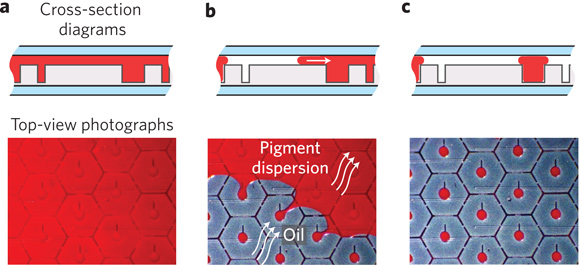
Although the Kindle 2’s screen is much improved over the first one’s, it still lacks the contrast and brightness of a normal piece of paper. Obviously real paper is the gold standard for e-paper, and lots of research is being done to make the devices more like the real thing. Research published in Nature Photonics describes an e-ink display method that promises to be faster and more versatile than current tech.
It seems that what’s done is simple: pushing ink out of a hole, and then pulling it back in. Surface tension and viscosity levels at this tiny scale mean it can be done incredibly fast, and very reliably. Tested monochrome displays had a black-to-white response time of under 1 millisecond, far better than anything on the market. Add a couple layers with red, blue, and yellow inks and you’ve got yourself a color display. And at 300dpi (the theoretical minimum size of a “pixel”), it might actually be pretty damn sharp. The thinness of the display element (around 15 micrometers) means that it could also be used in a rollable device.
The supplementary information part of the article has a couple cool-looking videos that demonstrate what the little ink pores look like in action on a micro scale.
Of course, as usual with the research we report, this tech is far from being applied to consumer devices. But if you were wondering whether you should take the plunge and get a Kindle or what have you, it’s good to know that there’s better stuff down the line for sure.
[via Treehugger and MIT Technology Review]